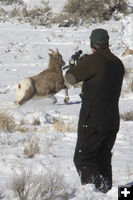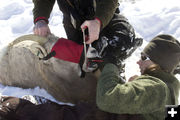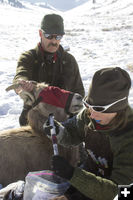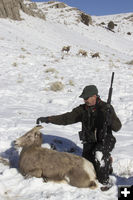

Tranquilizer Dart
Doug Brimeyer, Jackson Wildlife Biologist for the Wyoming Game and Fish Department, lands a tranquilizer dart in the rump of a bighorn sheep ewe on the National Elk Refuge near Jackson to collect biological samples for the presence of disease. Photo by Mark Gocke, Wyoming Game & Fish.
|


Collecting sample
Jessica Jennings-Gaines, a wildlife disease biologist for the Wyoming Game and Fish Department collects a tonsil swab sample from a tranquilized bighorn sheep ewe on the National Elk Refuge near Jackson on Thursday. Photo by Mark Gocke, Wyoming Game & Fish.
|


Blood sample
Jessica Jennings-Gaines, a wildlife disease biologist for the Wyoming Game and Fish Department collects a blood sample from a tranquilized bighorn sheep ewe on the National Elk Refuge near Jackson on Thursday. Photo by Mark Gocke, Wyoming Game & Fish.
|


Coming out of it
Doug Brimeyer, Jackson Wildlife Biologist for the Wyoming Game and Fish Department, assists a bighorn sheep ewe as it comes out of a tranquilizer drug on the National Elk Refuge near Jackson on Thursday. Photo by Mark Gocke, Wyoming Game & Fish.
|
|
Game and Fish captures Bighorn Sheep to monitor disease
by Wyoming Game & Fish
January 5, 2013
The Wyoming Game and Fish Department has begun to capture bighorn sheep this winter to monitor the presence of pneumonia in the Jackson Region. Nasal and tonsil swabs, along with blood, are being collected from sheep east of Jackson.
The Jackson herd experienced a significant die-off due to pneumonia in 2002. Wildlife Biologist Doug Brimeyer, estimates as much as half of the herd (which numbered approximately 500 sheep at the time) died in 2002. Near Dubois, the Whiskey Basin herd in the Wind River Range has struggled through several pneumonia outbreaks as well. Similarly, several bighorn sheep herds across the Rocky Mountain west have experienced significant declines in population due to pneumonia in recent years.
While there are several pathogens that can cause pneumonia in bighorn sheep, many of these are normally suppressed unless the animal becomes weakened by other pathogens or environmental stressors. Once the animalís immune system is undermined, these pathogens are able to establish themselves and cause disease.
"We became concerned about sheep in the Jackson herd this summer when approximately 20 percent, or four of twenty radio-collared sheep died," said Brimeyer. Laboratory results from sheep that died this summer indicate that the sheep had Mycoplasma ovipneumoniae, a pathogen that has been implicated in other bighorn sheep die-offs across the West.
"Although there is some debate regarding the pathogenís virulence in bighorn sheep, wildlife managers consider its presence a red flag warranting closer monitoring of the stateís bighorn sheep herds," said Hank Edwards, a wildlife disease specialist with Game and Fish. Brimeyer noted that some of the sheep observed on winter ranges were coughing, but otherwise appeared in good health.
Last winter, biologists collected samples for laboratory analysis and fitted GPS collars to animals wintering in five distinct areas near Jackson: the Gray Hills, Red Hills and Slide Lake areas in the Gros Ventre drainage, as well as Miller Butte on the National Elk Refuge and Hoback Canyon south of Jackson. Monitoring the animals will help identify migration corridors between winter and summer ranges, and help determine whether the different segments of the herd intermingle on lambing and summer ranges. The information also will help wildlife managers determine the potential scope of a pneumonia outbreak, should it occur.
This past summer wildlife managers learned that sheep collared on the National Elk Refuge migrated to a high-elevation plateau east of the "Sleeping Indian" (Sheep Mountain). Also, several ewes migrated into Granite Creek, to an area southwest of Granite Hot Springs. Sheep that were collared in the Gros Ventre also migrated to the plateau east of the Sleeping Indian, and to high-elevation areas in Crystal Creek. "This research provides a good start in helping managers understand these movement patterns and the potential spread of disease in the herd," said Brimeyer.
The Wyoming Wild Sheep Foundation provided funding for this winterís monitoring effort. A variety of sources funded the radio collar study, including the Wyoming Governorís Big Game License Coalition, University of Wyoming, Montana State University, and the Jackson chapters of Sportsmen for Fish and Wildlife and Safari Club International.
|



